Talent Management Strategies for Employee Retention at Apple
VerifiedAdded on 2023/01/06
|22
|4598
|20
Report
AI Summary
This report provides an in-depth analysis of Apple's talent management strategies, focusing on employee retention and attraction within the competitive electronic sector. The study begins with an overview of talent management, its significance, and the background of Apple as a multinational technology company. It aims to identify effective strategies for attracting and retaining skilled employees, examining the roles of leaders and managers in fostering a productive work environment. The research explores the effectiveness of strategic talent management, emphasizing the importance of leadership styles, employee motivation, and creating a supportive work culture. The literature review covers various strategies for managing and retaining talent, including rewards, safe working environments, and employee-focused cultures. The methodology section outlines the research approach, which is qualitative, employing an inductive approach and secondary data through literature review, with primary data collection via questionnaires. The report utilizes thematic analysis for data analysis and adheres to ethical considerations. The discussion and analysis sections delve into the findings, offering insights into Apple's current practices and potential improvements. The report concludes with recommendations for enhancing talent management strategies, addressing limitations, and suggesting areas for future research. This comprehensive analysis aims to provide valuable insights into Apple's talent management practices and strategies for optimizing employee retention and attraction.
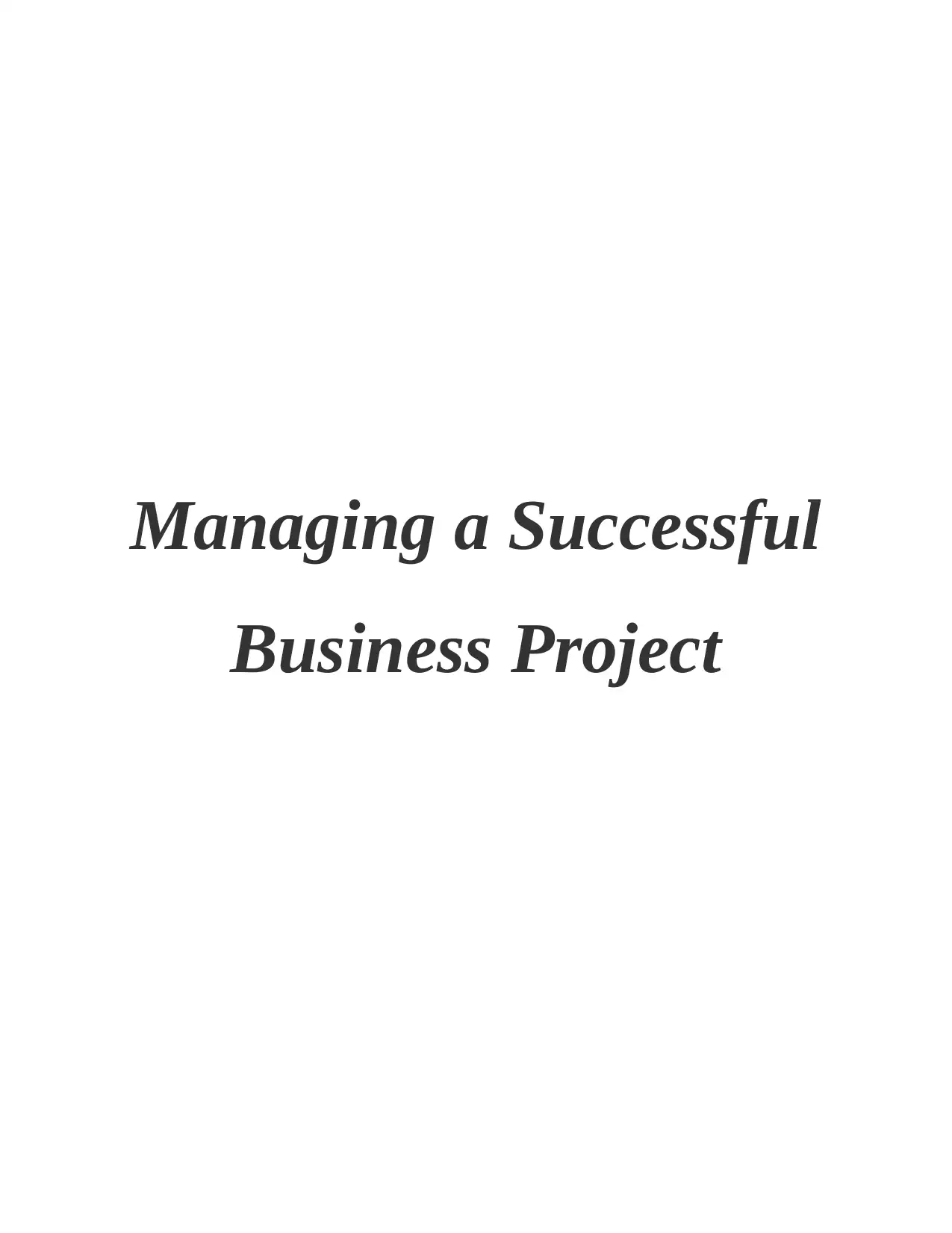
Managing a Successful
Business Project
Business Project
Paraphrase This Document
Need a fresh take? Get an instant paraphrase of this document with our AI Paraphraser
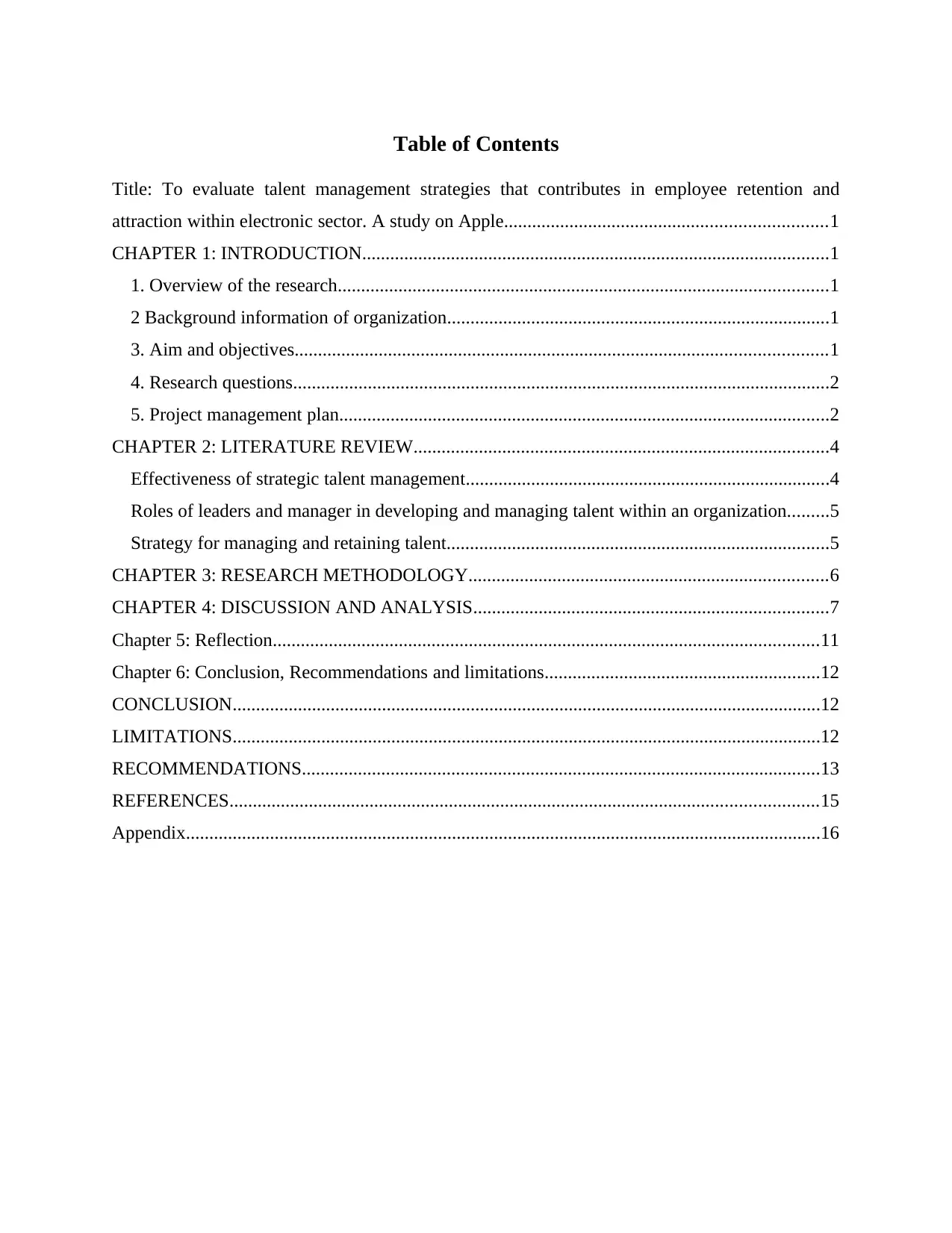
Table of Contents
Title: To evaluate talent management strategies that contributes in employee retention and
attraction within electronic sector. A study on Apple.....................................................................1
CHAPTER 1: INTRODUCTION....................................................................................................1
1. Overview of the research.........................................................................................................1
2 Background information of organization..................................................................................1
3. Aim and objectives..................................................................................................................1
4. Research questions...................................................................................................................2
5. Project management plan.........................................................................................................2
CHAPTER 2: LITERATURE REVIEW.........................................................................................4
Effectiveness of strategic talent management..............................................................................4
Roles of leaders and manager in developing and managing talent within an organization.........5
Strategy for managing and retaining talent..................................................................................5
CHAPTER 3: RESEARCH METHODOLOGY.............................................................................6
CHAPTER 4: DISCUSSION AND ANALYSIS............................................................................7
Chapter 5: Reflection.....................................................................................................................11
Chapter 6: Conclusion, Recommendations and limitations...........................................................12
CONCLUSION..............................................................................................................................12
LIMITATIONS..............................................................................................................................12
RECOMMENDATIONS...............................................................................................................13
REFERENCES..............................................................................................................................15
Appendix........................................................................................................................................16
Title: To evaluate talent management strategies that contributes in employee retention and
attraction within electronic sector. A study on Apple.....................................................................1
CHAPTER 1: INTRODUCTION....................................................................................................1
1. Overview of the research.........................................................................................................1
2 Background information of organization..................................................................................1
3. Aim and objectives..................................................................................................................1
4. Research questions...................................................................................................................2
5. Project management plan.........................................................................................................2
CHAPTER 2: LITERATURE REVIEW.........................................................................................4
Effectiveness of strategic talent management..............................................................................4
Roles of leaders and manager in developing and managing talent within an organization.........5
Strategy for managing and retaining talent..................................................................................5
CHAPTER 3: RESEARCH METHODOLOGY.............................................................................6
CHAPTER 4: DISCUSSION AND ANALYSIS............................................................................7
Chapter 5: Reflection.....................................................................................................................11
Chapter 6: Conclusion, Recommendations and limitations...........................................................12
CONCLUSION..............................................................................................................................12
LIMITATIONS..............................................................................................................................12
RECOMMENDATIONS...............................................................................................................13
REFERENCES..............................................................................................................................15
Appendix........................................................................................................................................16
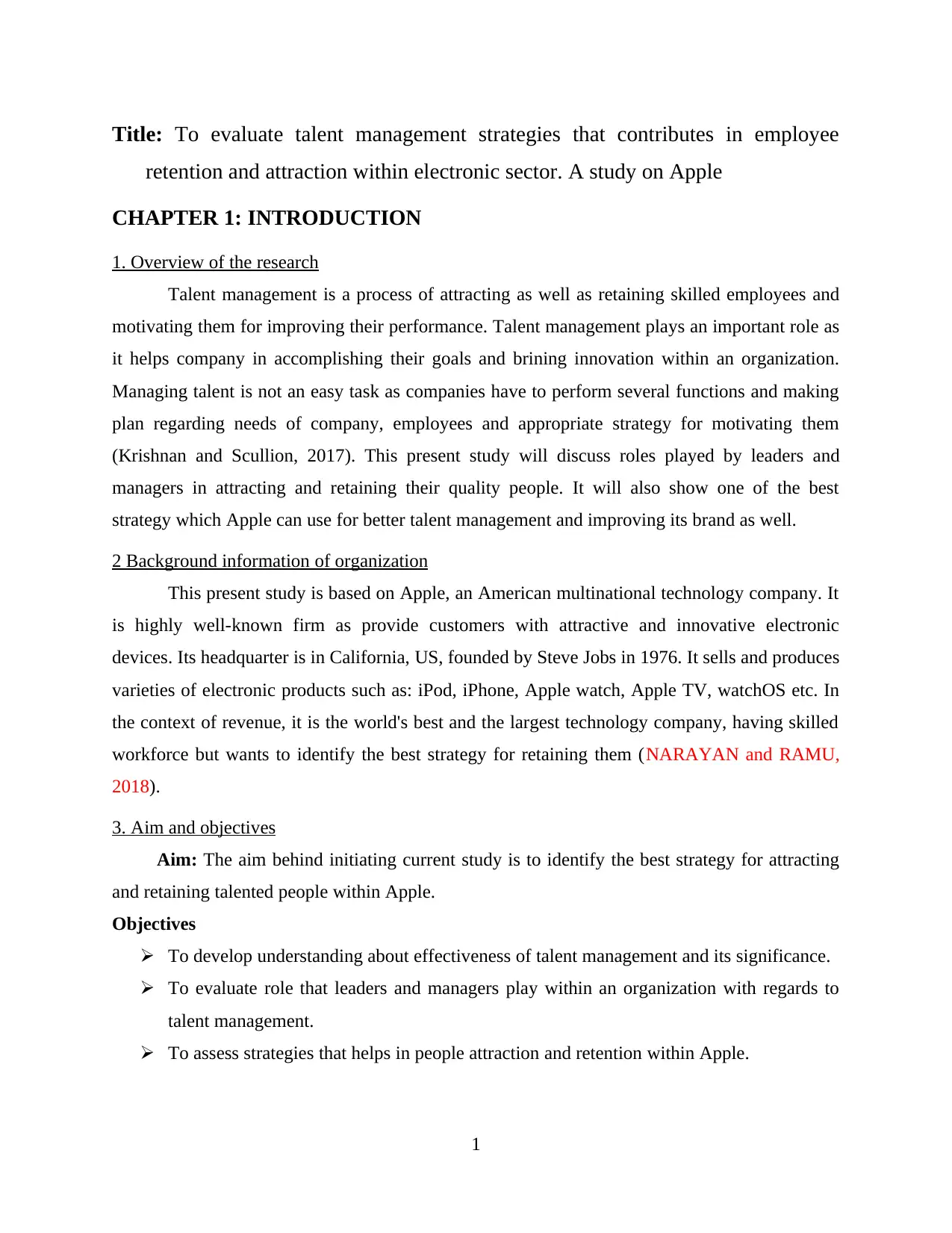
Title: To evaluate talent management strategies that contributes in employee
retention and attraction within electronic sector. A study on Apple
CHAPTER 1: INTRODUCTION
1. Overview of the research
Talent management is a process of attracting as well as retaining skilled employees and
motivating them for improving their performance. Talent management plays an important role as
it helps company in accomplishing their goals and brining innovation within an organization.
Managing talent is not an easy task as companies have to perform several functions and making
plan regarding needs of company, employees and appropriate strategy for motivating them
(Krishnan and Scullion, 2017). This present study will discuss roles played by leaders and
managers in attracting and retaining their quality people. It will also show one of the best
strategy which Apple can use for better talent management and improving its brand as well.
2 Background information of organization
This present study is based on Apple, an American multinational technology company. It
is highly well-known firm as provide customers with attractive and innovative electronic
devices. Its headquarter is in California, US, founded by Steve Jobs in 1976. It sells and produces
varieties of electronic products such as: iPod, iPhone, Apple watch, Apple TV, watchOS etc. In
the context of revenue, it is the world's best and the largest technology company, having skilled
workforce but wants to identify the best strategy for retaining them (NARAYAN and RAMU,
2018).
3. Aim and objectives
Aim: The aim behind initiating current study is to identify the best strategy for attracting
and retaining talented people within Apple.
Objectives
To develop understanding about effectiveness of talent management and its significance.
To evaluate role that leaders and managers play within an organization with regards to
talent management.
To assess strategies that helps in people attraction and retention within Apple.
1
retention and attraction within electronic sector. A study on Apple
CHAPTER 1: INTRODUCTION
1. Overview of the research
Talent management is a process of attracting as well as retaining skilled employees and
motivating them for improving their performance. Talent management plays an important role as
it helps company in accomplishing their goals and brining innovation within an organization.
Managing talent is not an easy task as companies have to perform several functions and making
plan regarding needs of company, employees and appropriate strategy for motivating them
(Krishnan and Scullion, 2017). This present study will discuss roles played by leaders and
managers in attracting and retaining their quality people. It will also show one of the best
strategy which Apple can use for better talent management and improving its brand as well.
2 Background information of organization
This present study is based on Apple, an American multinational technology company. It
is highly well-known firm as provide customers with attractive and innovative electronic
devices. Its headquarter is in California, US, founded by Steve Jobs in 1976. It sells and produces
varieties of electronic products such as: iPod, iPhone, Apple watch, Apple TV, watchOS etc. In
the context of revenue, it is the world's best and the largest technology company, having skilled
workforce but wants to identify the best strategy for retaining them (NARAYAN and RAMU,
2018).
3. Aim and objectives
Aim: The aim behind initiating current study is to identify the best strategy for attracting
and retaining talented people within Apple.
Objectives
To develop understanding about effectiveness of talent management and its significance.
To evaluate role that leaders and managers play within an organization with regards to
talent management.
To assess strategies that helps in people attraction and retention within Apple.
1
⊘ This is a preview!⊘
Do you want full access?
Subscribe today to unlock all pages.

Trusted by 1+ million students worldwide
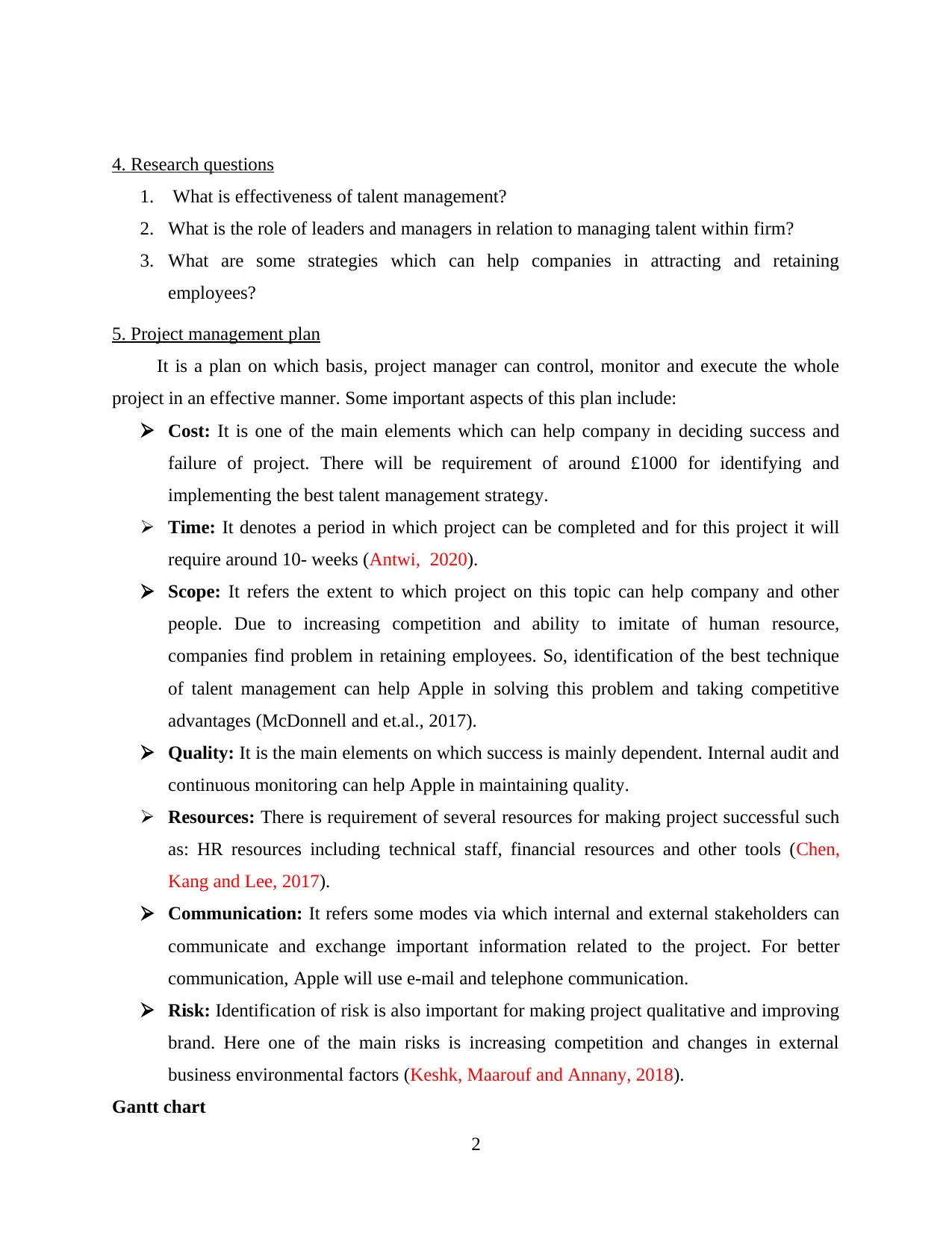
4. Research questions
1. What is effectiveness of talent management?
2. What is the role of leaders and managers in relation to managing talent within firm?
3. What are some strategies which can help companies in attracting and retaining
employees?
5. Project management plan
It is a plan on which basis, project manager can control, monitor and execute the whole
project in an effective manner. Some important aspects of this plan include:
Cost: It is one of the main elements which can help company in deciding success and
failure of project. There will be requirement of around £1000 for identifying and
implementing the best talent management strategy.
Time: It denotes a period in which project can be completed and for this project it will
require around 10- weeks (Antwi, 2020).
Scope: It refers the extent to which project on this topic can help company and other
people. Due to increasing competition and ability to imitate of human resource,
companies find problem in retaining employees. So, identification of the best technique
of talent management can help Apple in solving this problem and taking competitive
advantages (McDonnell and et.al., 2017).
Quality: It is the main elements on which success is mainly dependent. Internal audit and
continuous monitoring can help Apple in maintaining quality.
Resources: There is requirement of several resources for making project successful such
as: HR resources including technical staff, financial resources and other tools (Chen,
Kang and Lee, 2017).
Communication: It refers some modes via which internal and external stakeholders can
communicate and exchange important information related to the project. For better
communication, Apple will use e-mail and telephone communication.
Risk: Identification of risk is also important for making project qualitative and improving
brand. Here one of the main risks is increasing competition and changes in external
business environmental factors (Keshk, Maarouf and Annany, 2018).
Gantt chart
2
1. What is effectiveness of talent management?
2. What is the role of leaders and managers in relation to managing talent within firm?
3. What are some strategies which can help companies in attracting and retaining
employees?
5. Project management plan
It is a plan on which basis, project manager can control, monitor and execute the whole
project in an effective manner. Some important aspects of this plan include:
Cost: It is one of the main elements which can help company in deciding success and
failure of project. There will be requirement of around £1000 for identifying and
implementing the best talent management strategy.
Time: It denotes a period in which project can be completed and for this project it will
require around 10- weeks (Antwi, 2020).
Scope: It refers the extent to which project on this topic can help company and other
people. Due to increasing competition and ability to imitate of human resource,
companies find problem in retaining employees. So, identification of the best technique
of talent management can help Apple in solving this problem and taking competitive
advantages (McDonnell and et.al., 2017).
Quality: It is the main elements on which success is mainly dependent. Internal audit and
continuous monitoring can help Apple in maintaining quality.
Resources: There is requirement of several resources for making project successful such
as: HR resources including technical staff, financial resources and other tools (Chen,
Kang and Lee, 2017).
Communication: It refers some modes via which internal and external stakeholders can
communicate and exchange important information related to the project. For better
communication, Apple will use e-mail and telephone communication.
Risk: Identification of risk is also important for making project qualitative and improving
brand. Here one of the main risks is increasing competition and changes in external
business environmental factors (Keshk, Maarouf and Annany, 2018).
Gantt chart
2
Paraphrase This Document
Need a fresh take? Get an instant paraphrase of this document with our AI Paraphraser
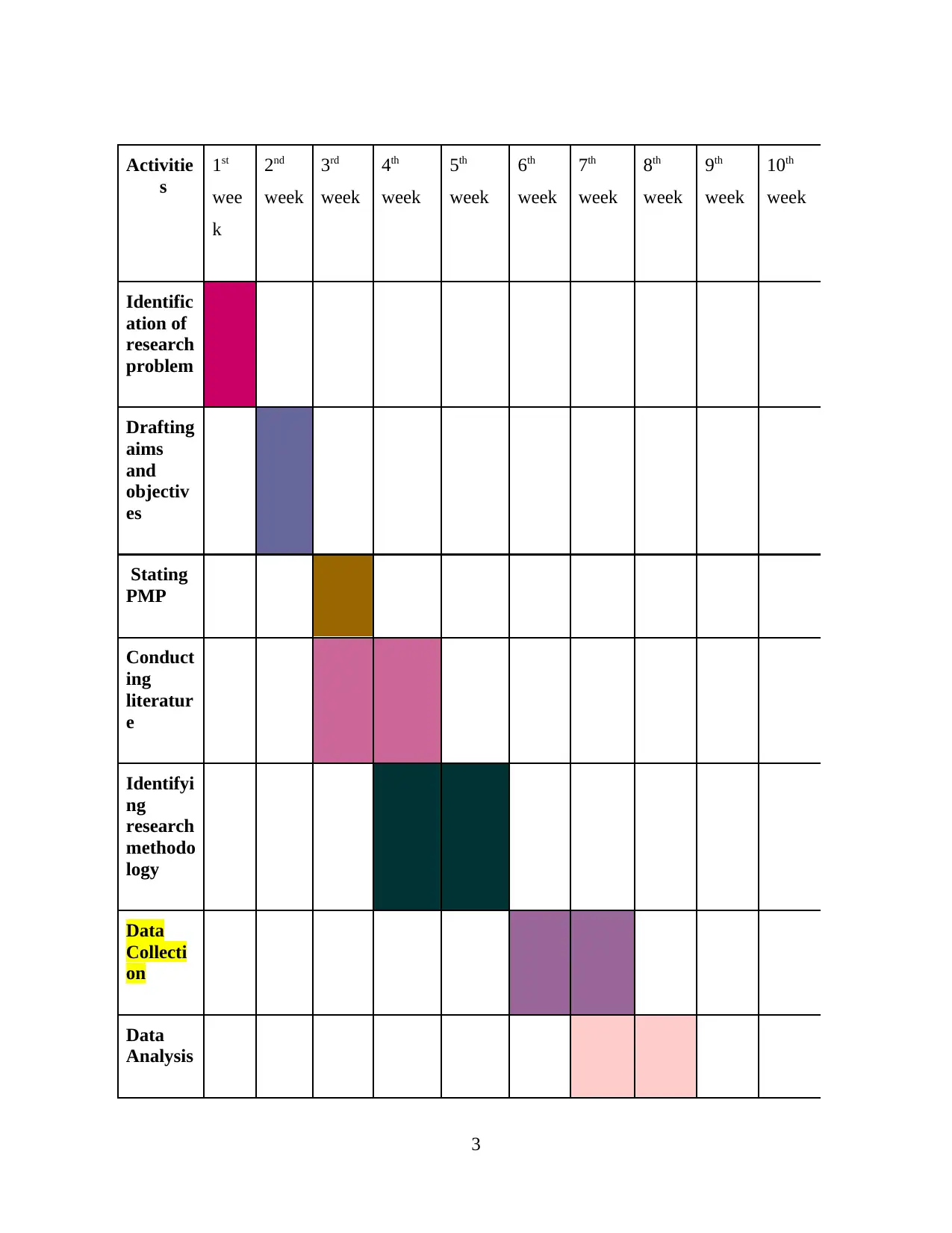
Activitie
s
1st
wee
k
2nd
week
3rd
week
4th
week
5th
week
6th
week
7th
week
8th
week
9th
week
10th
week
Identific
ation of
research
problem
Drafting
aims
and
objectiv
es
Stating
PMP
Conduct
ing
literatur
e
Identifyi
ng
research
methodo
logy
Data
Collecti
on
Data
Analysis
3
s
1st
wee
k
2nd
week
3rd
week
4th
week
5th
week
6th
week
7th
week
8th
week
9th
week
10th
week
Identific
ation of
research
problem
Drafting
aims
and
objectiv
es
Stating
PMP
Conduct
ing
literatur
e
Identifyi
ng
research
methodo
logy
Data
Collecti
on
Data
Analysis
3
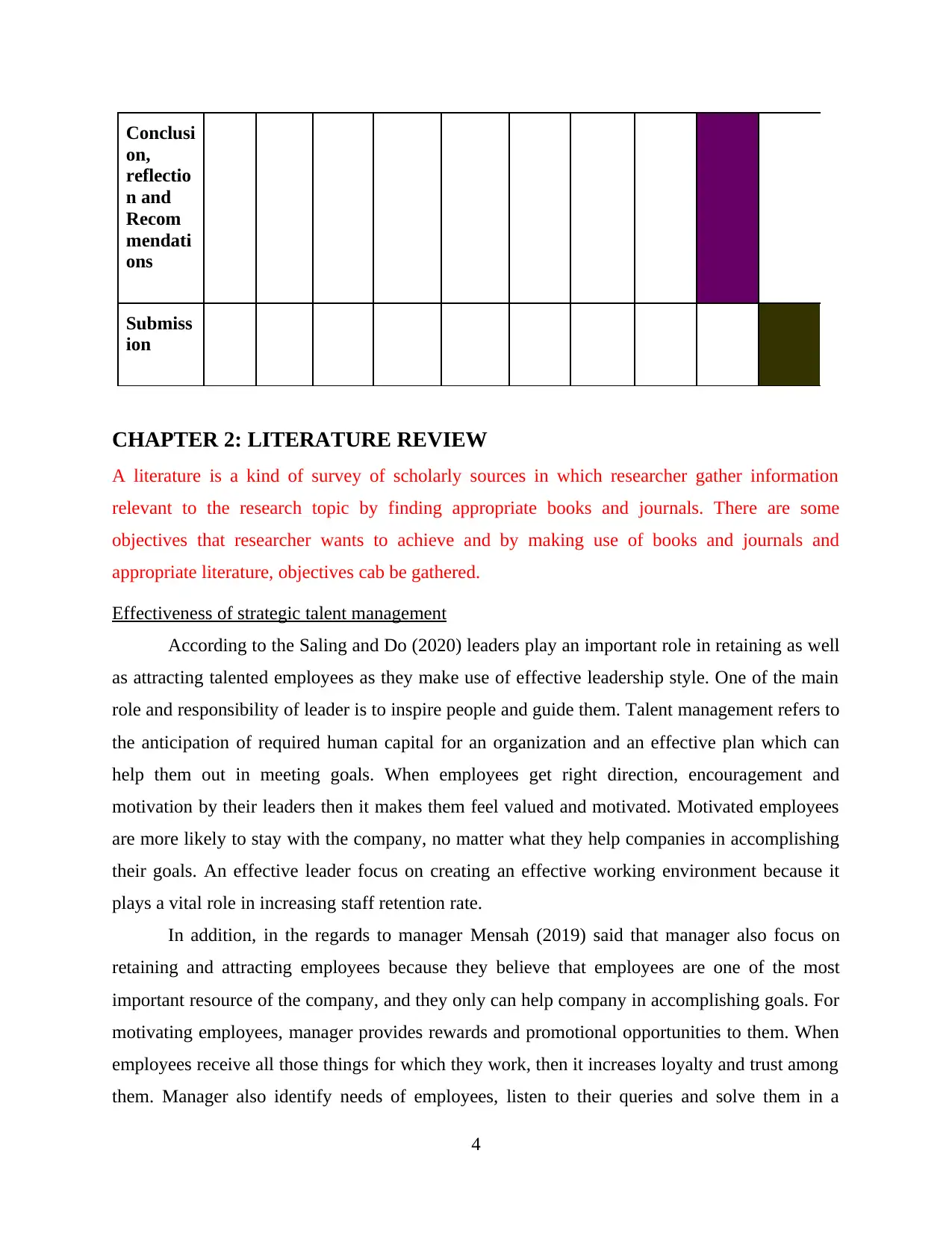
Conclusi
on,
reflectio
n and
Recom
mendati
ons
Submiss
ion
CHAPTER 2: LITERATURE REVIEW
A literature is a kind of survey of scholarly sources in which researcher gather information
relevant to the research topic by finding appropriate books and journals. There are some
objectives that researcher wants to achieve and by making use of books and journals and
appropriate literature, objectives cab be gathered.
Effectiveness of strategic talent management
According to the Saling and Do (2020) leaders play an important role in retaining as well
as attracting talented employees as they make use of effective leadership style. One of the main
role and responsibility of leader is to inspire people and guide them. Talent management refers to
the anticipation of required human capital for an organization and an effective plan which can
help them out in meeting goals. When employees get right direction, encouragement and
motivation by their leaders then it makes them feel valued and motivated. Motivated employees
are more likely to stay with the company, no matter what they help companies in accomplishing
their goals. An effective leader focus on creating an effective working environment because it
plays a vital role in increasing staff retention rate.
In addition, in the regards to manager Mensah (2019) said that manager also focus on
retaining and attracting employees because they believe that employees are one of the most
important resource of the company, and they only can help company in accomplishing goals. For
motivating employees, manager provides rewards and promotional opportunities to them. When
employees receive all those things for which they work, then it increases loyalty and trust among
them. Manager also identify needs of employees, listen to their queries and solve them in a
4
on,
reflectio
n and
Recom
mendati
ons
Submiss
ion
CHAPTER 2: LITERATURE REVIEW
A literature is a kind of survey of scholarly sources in which researcher gather information
relevant to the research topic by finding appropriate books and journals. There are some
objectives that researcher wants to achieve and by making use of books and journals and
appropriate literature, objectives cab be gathered.
Effectiveness of strategic talent management
According to the Saling and Do (2020) leaders play an important role in retaining as well
as attracting talented employees as they make use of effective leadership style. One of the main
role and responsibility of leader is to inspire people and guide them. Talent management refers to
the anticipation of required human capital for an organization and an effective plan which can
help them out in meeting goals. When employees get right direction, encouragement and
motivation by their leaders then it makes them feel valued and motivated. Motivated employees
are more likely to stay with the company, no matter what they help companies in accomplishing
their goals. An effective leader focus on creating an effective working environment because it
plays a vital role in increasing staff retention rate.
In addition, in the regards to manager Mensah (2019) said that manager also focus on
retaining and attracting employees because they believe that employees are one of the most
important resource of the company, and they only can help company in accomplishing goals. For
motivating employees, manager provides rewards and promotional opportunities to them. When
employees receive all those things for which they work, then it increases loyalty and trust among
them. Manager also identify needs of employees, listen to their queries and solve them in a
4
⊘ This is a preview!⊘
Do you want full access?
Subscribe today to unlock all pages.

Trusted by 1+ million students worldwide
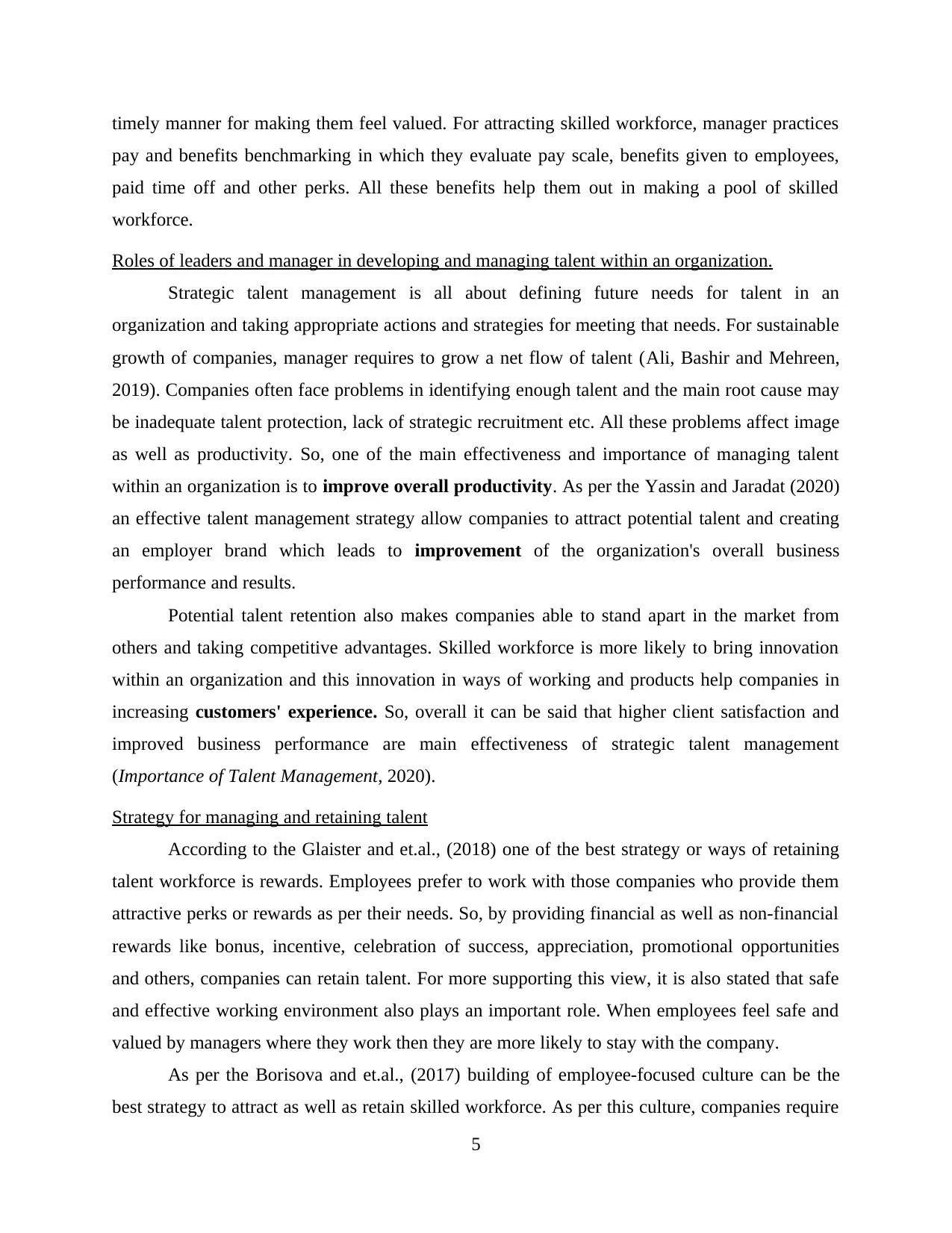
timely manner for making them feel valued. For attracting skilled workforce, manager practices
pay and benefits benchmarking in which they evaluate pay scale, benefits given to employees,
paid time off and other perks. All these benefits help them out in making a pool of skilled
workforce.
Roles of leaders and manager in developing and managing talent within an organization.
Strategic talent management is all about defining future needs for talent in an
organization and taking appropriate actions and strategies for meeting that needs. For sustainable
growth of companies, manager requires to grow a net flow of talent (Ali, Bashir and Mehreen,
2019). Companies often face problems in identifying enough talent and the main root cause may
be inadequate talent protection, lack of strategic recruitment etc. All these problems affect image
as well as productivity. So, one of the main effectiveness and importance of managing talent
within an organization is to improve overall productivity. As per the Yassin and Jaradat (2020)
an effective talent management strategy allow companies to attract potential talent and creating
an employer brand which leads to improvement of the organization's overall business
performance and results.
Potential talent retention also makes companies able to stand apart in the market from
others and taking competitive advantages. Skilled workforce is more likely to bring innovation
within an organization and this innovation in ways of working and products help companies in
increasing customers' experience. So, overall it can be said that higher client satisfaction and
improved business performance are main effectiveness of strategic talent management
(Importance of Talent Management, 2020).
Strategy for managing and retaining talent
According to the Glaister and et.al., (2018) one of the best strategy or ways of retaining
talent workforce is rewards. Employees prefer to work with those companies who provide them
attractive perks or rewards as per their needs. So, by providing financial as well as non-financial
rewards like bonus, incentive, celebration of success, appreciation, promotional opportunities
and others, companies can retain talent. For more supporting this view, it is also stated that safe
and effective working environment also plays an important role. When employees feel safe and
valued by managers where they work then they are more likely to stay with the company.
As per the Borisova and et.al., (2017) building of employee-focused culture can be the
best strategy to attract as well as retain skilled workforce. As per this culture, companies require
5
pay and benefits benchmarking in which they evaluate pay scale, benefits given to employees,
paid time off and other perks. All these benefits help them out in making a pool of skilled
workforce.
Roles of leaders and manager in developing and managing talent within an organization.
Strategic talent management is all about defining future needs for talent in an
organization and taking appropriate actions and strategies for meeting that needs. For sustainable
growth of companies, manager requires to grow a net flow of talent (Ali, Bashir and Mehreen,
2019). Companies often face problems in identifying enough talent and the main root cause may
be inadequate talent protection, lack of strategic recruitment etc. All these problems affect image
as well as productivity. So, one of the main effectiveness and importance of managing talent
within an organization is to improve overall productivity. As per the Yassin and Jaradat (2020)
an effective talent management strategy allow companies to attract potential talent and creating
an employer brand which leads to improvement of the organization's overall business
performance and results.
Potential talent retention also makes companies able to stand apart in the market from
others and taking competitive advantages. Skilled workforce is more likely to bring innovation
within an organization and this innovation in ways of working and products help companies in
increasing customers' experience. So, overall it can be said that higher client satisfaction and
improved business performance are main effectiveness of strategic talent management
(Importance of Talent Management, 2020).
Strategy for managing and retaining talent
According to the Glaister and et.al., (2018) one of the best strategy or ways of retaining
talent workforce is rewards. Employees prefer to work with those companies who provide them
attractive perks or rewards as per their needs. So, by providing financial as well as non-financial
rewards like bonus, incentive, celebration of success, appreciation, promotional opportunities
and others, companies can retain talent. For more supporting this view, it is also stated that safe
and effective working environment also plays an important role. When employees feel safe and
valued by managers where they work then they are more likely to stay with the company.
As per the Borisova and et.al., (2017) building of employee-focused culture can be the
best strategy to attract as well as retain skilled workforce. As per this culture, companies require
5
Paraphrase This Document
Need a fresh take? Get an instant paraphrase of this document with our AI Paraphraser
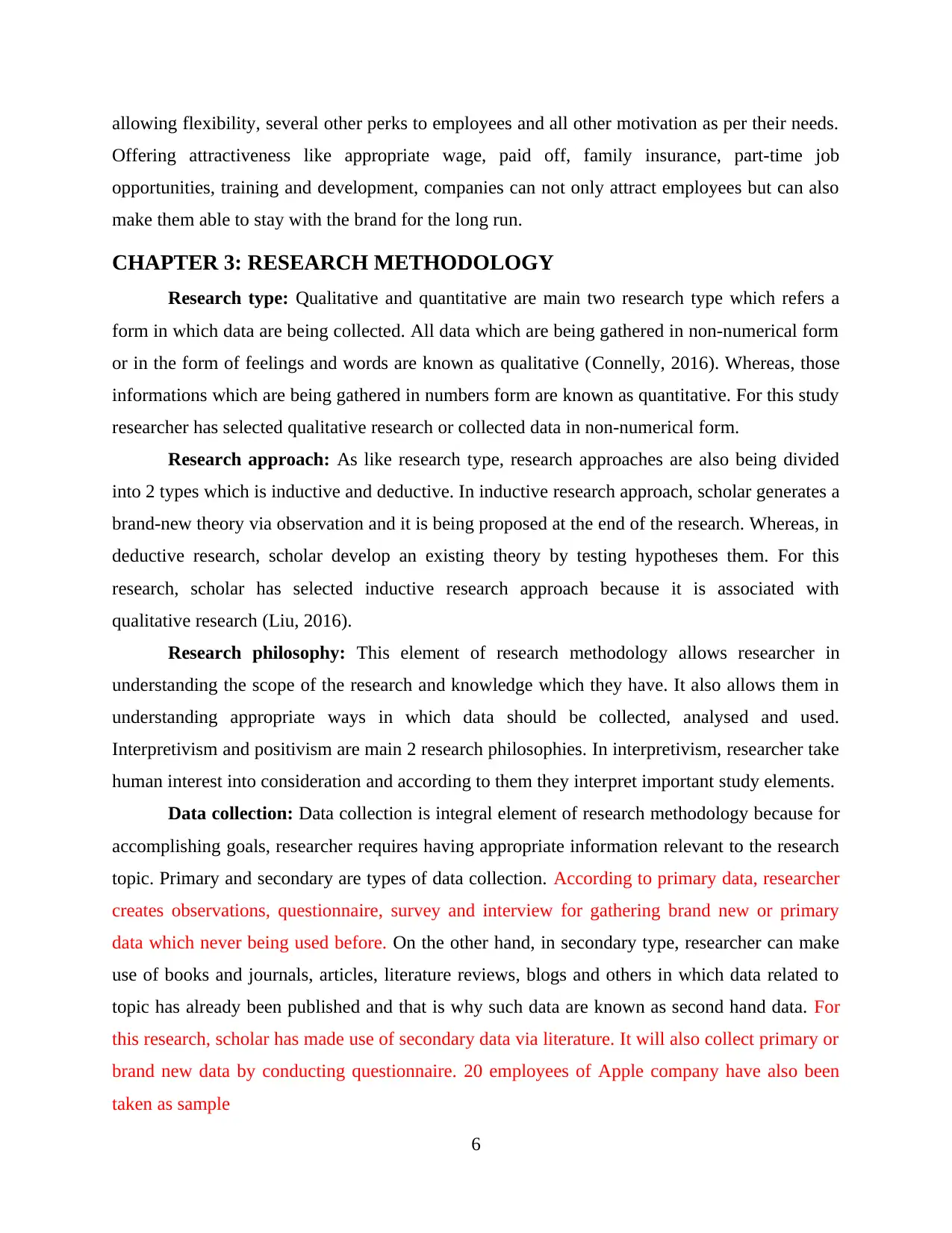
allowing flexibility, several other perks to employees and all other motivation as per their needs.
Offering attractiveness like appropriate wage, paid off, family insurance, part-time job
opportunities, training and development, companies can not only attract employees but can also
make them able to stay with the brand for the long run.
CHAPTER 3: RESEARCH METHODOLOGY
Research type: Qualitative and quantitative are main two research type which refers a
form in which data are being collected. All data which are being gathered in non-numerical form
or in the form of feelings and words are known as qualitative (Connelly, 2016). Whereas, those
informations which are being gathered in numbers form are known as quantitative. For this study
researcher has selected qualitative research or collected data in non-numerical form.
Research approach: As like research type, research approaches are also being divided
into 2 types which is inductive and deductive. In inductive research approach, scholar generates a
brand-new theory via observation and it is being proposed at the end of the research. Whereas, in
deductive research, scholar develop an existing theory by testing hypotheses them. For this
research, scholar has selected inductive research approach because it is associated with
qualitative research (Liu, 2016).
Research philosophy: This element of research methodology allows researcher in
understanding the scope of the research and knowledge which they have. It also allows them in
understanding appropriate ways in which data should be collected, analysed and used.
Interpretivism and positivism are main 2 research philosophies. In interpretivism, researcher take
human interest into consideration and according to them they interpret important study elements.
Data collection: Data collection is integral element of research methodology because for
accomplishing goals, researcher requires having appropriate information relevant to the research
topic. Primary and secondary are types of data collection. According to primary data, researcher
creates observations, questionnaire, survey and interview for gathering brand new or primary
data which never being used before. On the other hand, in secondary type, researcher can make
use of books and journals, articles, literature reviews, blogs and others in which data related to
topic has already been published and that is why such data are known as second hand data. For
this research, scholar has made use of secondary data via literature. It will also collect primary or
brand new data by conducting questionnaire. 20 employees of Apple company have also been
taken as sample
6
Offering attractiveness like appropriate wage, paid off, family insurance, part-time job
opportunities, training and development, companies can not only attract employees but can also
make them able to stay with the brand for the long run.
CHAPTER 3: RESEARCH METHODOLOGY
Research type: Qualitative and quantitative are main two research type which refers a
form in which data are being collected. All data which are being gathered in non-numerical form
or in the form of feelings and words are known as qualitative (Connelly, 2016). Whereas, those
informations which are being gathered in numbers form are known as quantitative. For this study
researcher has selected qualitative research or collected data in non-numerical form.
Research approach: As like research type, research approaches are also being divided
into 2 types which is inductive and deductive. In inductive research approach, scholar generates a
brand-new theory via observation and it is being proposed at the end of the research. Whereas, in
deductive research, scholar develop an existing theory by testing hypotheses them. For this
research, scholar has selected inductive research approach because it is associated with
qualitative research (Liu, 2016).
Research philosophy: This element of research methodology allows researcher in
understanding the scope of the research and knowledge which they have. It also allows them in
understanding appropriate ways in which data should be collected, analysed and used.
Interpretivism and positivism are main 2 research philosophies. In interpretivism, researcher take
human interest into consideration and according to them they interpret important study elements.
Data collection: Data collection is integral element of research methodology because for
accomplishing goals, researcher requires having appropriate information relevant to the research
topic. Primary and secondary are types of data collection. According to primary data, researcher
creates observations, questionnaire, survey and interview for gathering brand new or primary
data which never being used before. On the other hand, in secondary type, researcher can make
use of books and journals, articles, literature reviews, blogs and others in which data related to
topic has already been published and that is why such data are known as second hand data. For
this research, scholar has made use of secondary data via literature. It will also collect primary or
brand new data by conducting questionnaire. 20 employees of Apple company have also been
taken as sample
6
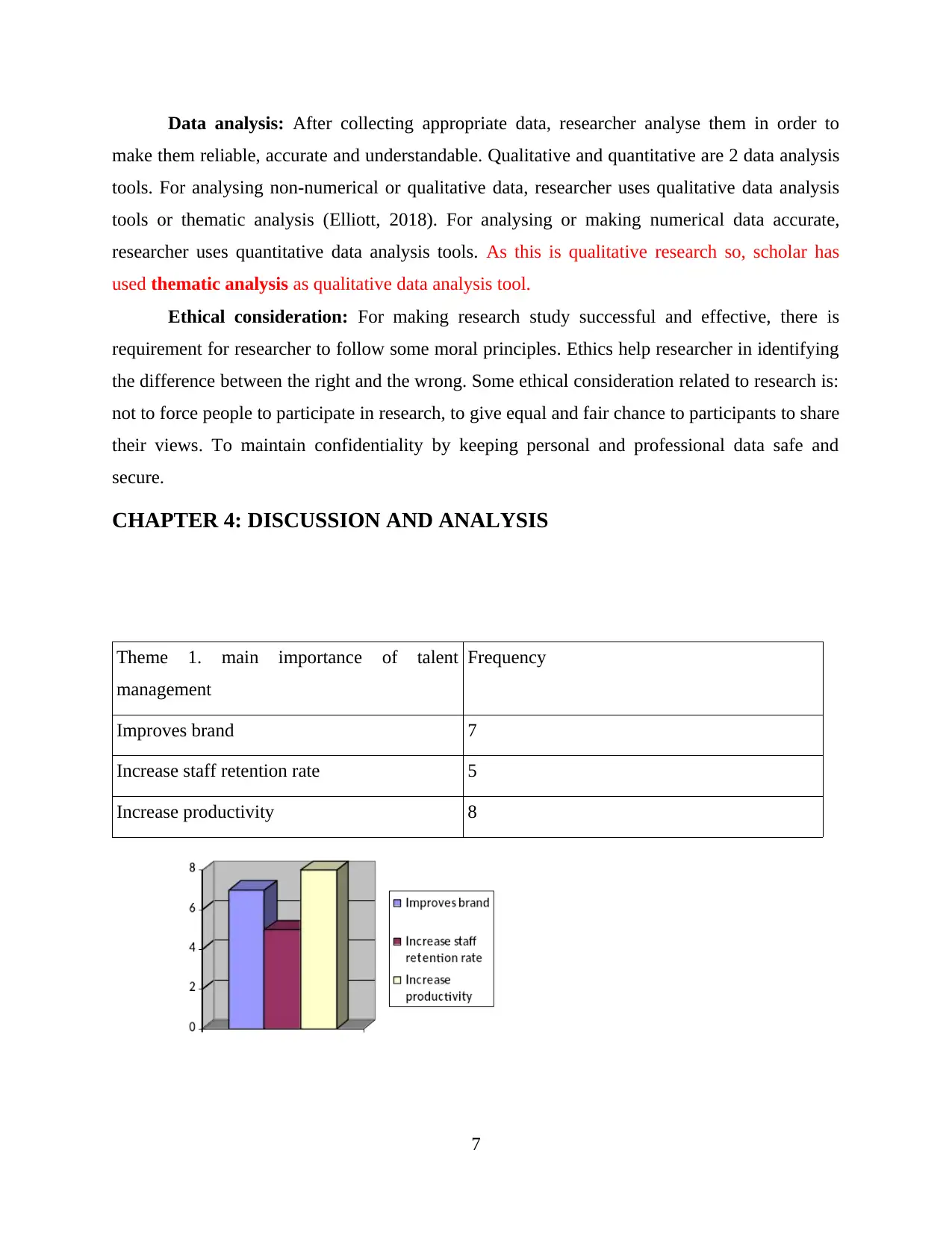
Data analysis: After collecting appropriate data, researcher analyse them in order to
make them reliable, accurate and understandable. Qualitative and quantitative are 2 data analysis
tools. For analysing non-numerical or qualitative data, researcher uses qualitative data analysis
tools or thematic analysis (Elliott, 2018). For analysing or making numerical data accurate,
researcher uses quantitative data analysis tools. As this is qualitative research so, scholar has
used thematic analysis as qualitative data analysis tool.
Ethical consideration: For making research study successful and effective, there is
requirement for researcher to follow some moral principles. Ethics help researcher in identifying
the difference between the right and the wrong. Some ethical consideration related to research is:
not to force people to participate in research, to give equal and fair chance to participants to share
their views. To maintain confidentiality by keeping personal and professional data safe and
secure.
CHAPTER 4: DISCUSSION AND ANALYSIS
Theme 1. main importance of talent
management
Frequency
Improves brand 7
Increase staff retention rate 5
Increase productivity 8
7
make them reliable, accurate and understandable. Qualitative and quantitative are 2 data analysis
tools. For analysing non-numerical or qualitative data, researcher uses qualitative data analysis
tools or thematic analysis (Elliott, 2018). For analysing or making numerical data accurate,
researcher uses quantitative data analysis tools. As this is qualitative research so, scholar has
used thematic analysis as qualitative data analysis tool.
Ethical consideration: For making research study successful and effective, there is
requirement for researcher to follow some moral principles. Ethics help researcher in identifying
the difference between the right and the wrong. Some ethical consideration related to research is:
not to force people to participate in research, to give equal and fair chance to participants to share
their views. To maintain confidentiality by keeping personal and professional data safe and
secure.
CHAPTER 4: DISCUSSION AND ANALYSIS
Theme 1. main importance of talent
management
Frequency
Improves brand 7
Increase staff retention rate 5
Increase productivity 8
7
⊘ This is a preview!⊘
Do you want full access?
Subscribe today to unlock all pages.

Trusted by 1+ million students worldwide
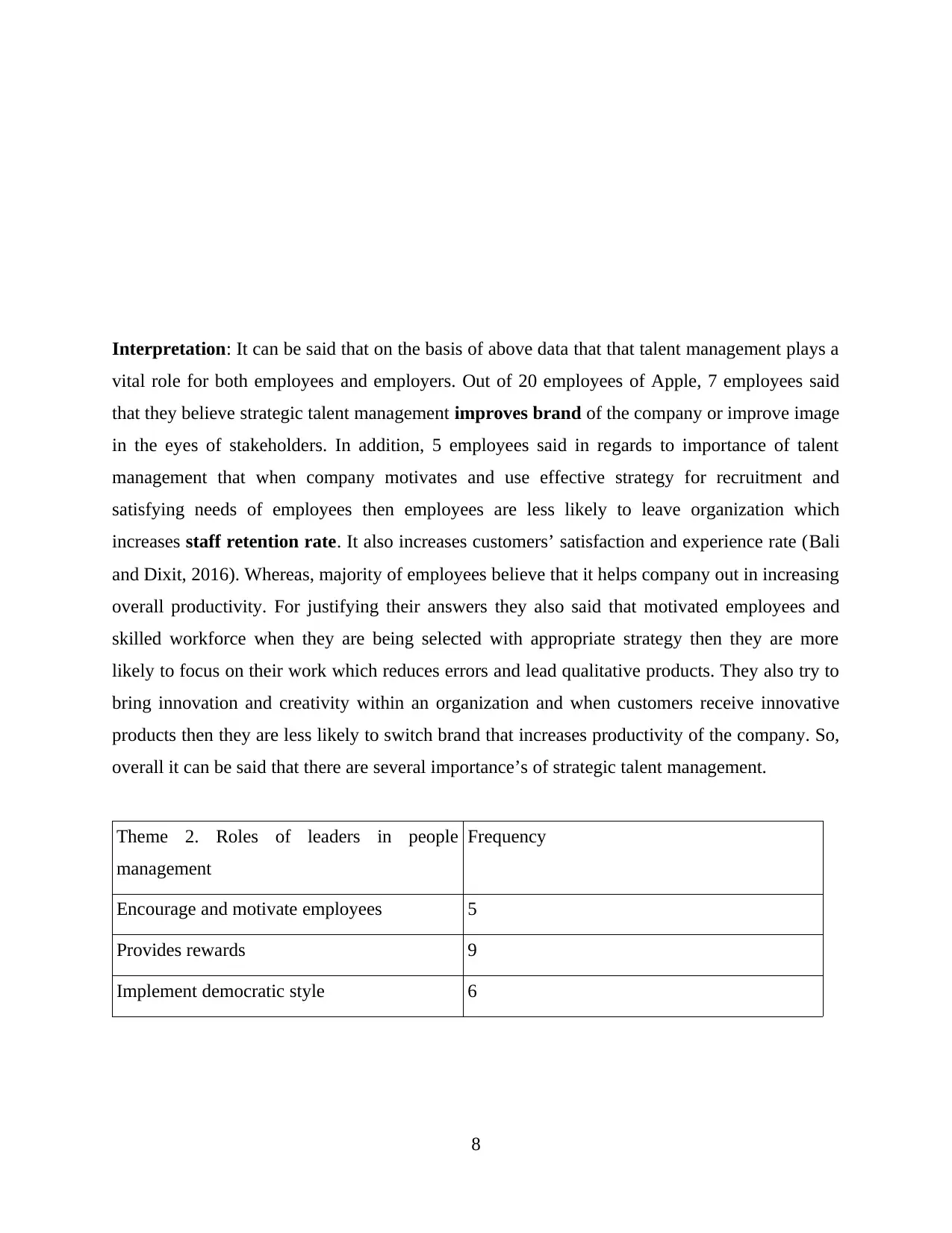
Interpretation: It can be said that on the basis of above data that that talent management plays a
vital role for both employees and employers. Out of 20 employees of Apple, 7 employees said
that they believe strategic talent management improves brand of the company or improve image
in the eyes of stakeholders. In addition, 5 employees said in regards to importance of talent
management that when company motivates and use effective strategy for recruitment and
satisfying needs of employees then employees are less likely to leave organization which
increases staff retention rate. It also increases customers’ satisfaction and experience rate (Bali
and Dixit, 2016). Whereas, majority of employees believe that it helps company out in increasing
overall productivity. For justifying their answers they also said that motivated employees and
skilled workforce when they are being selected with appropriate strategy then they are more
likely to focus on their work which reduces errors and lead qualitative products. They also try to
bring innovation and creativity within an organization and when customers receive innovative
products then they are less likely to switch brand that increases productivity of the company. So,
overall it can be said that there are several importance’s of strategic talent management.
Theme 2. Roles of leaders in people
management
Frequency
Encourage and motivate employees 5
Provides rewards 9
Implement democratic style 6
8
vital role for both employees and employers. Out of 20 employees of Apple, 7 employees said
that they believe strategic talent management improves brand of the company or improve image
in the eyes of stakeholders. In addition, 5 employees said in regards to importance of talent
management that when company motivates and use effective strategy for recruitment and
satisfying needs of employees then employees are less likely to leave organization which
increases staff retention rate. It also increases customers’ satisfaction and experience rate (Bali
and Dixit, 2016). Whereas, majority of employees believe that it helps company out in increasing
overall productivity. For justifying their answers they also said that motivated employees and
skilled workforce when they are being selected with appropriate strategy then they are more
likely to focus on their work which reduces errors and lead qualitative products. They also try to
bring innovation and creativity within an organization and when customers receive innovative
products then they are less likely to switch brand that increases productivity of the company. So,
overall it can be said that there are several importance’s of strategic talent management.
Theme 2. Roles of leaders in people
management
Frequency
Encourage and motivate employees 5
Provides rewards 9
Implement democratic style 6
8
Paraphrase This Document
Need a fresh take? Get an instant paraphrase of this document with our AI Paraphraser
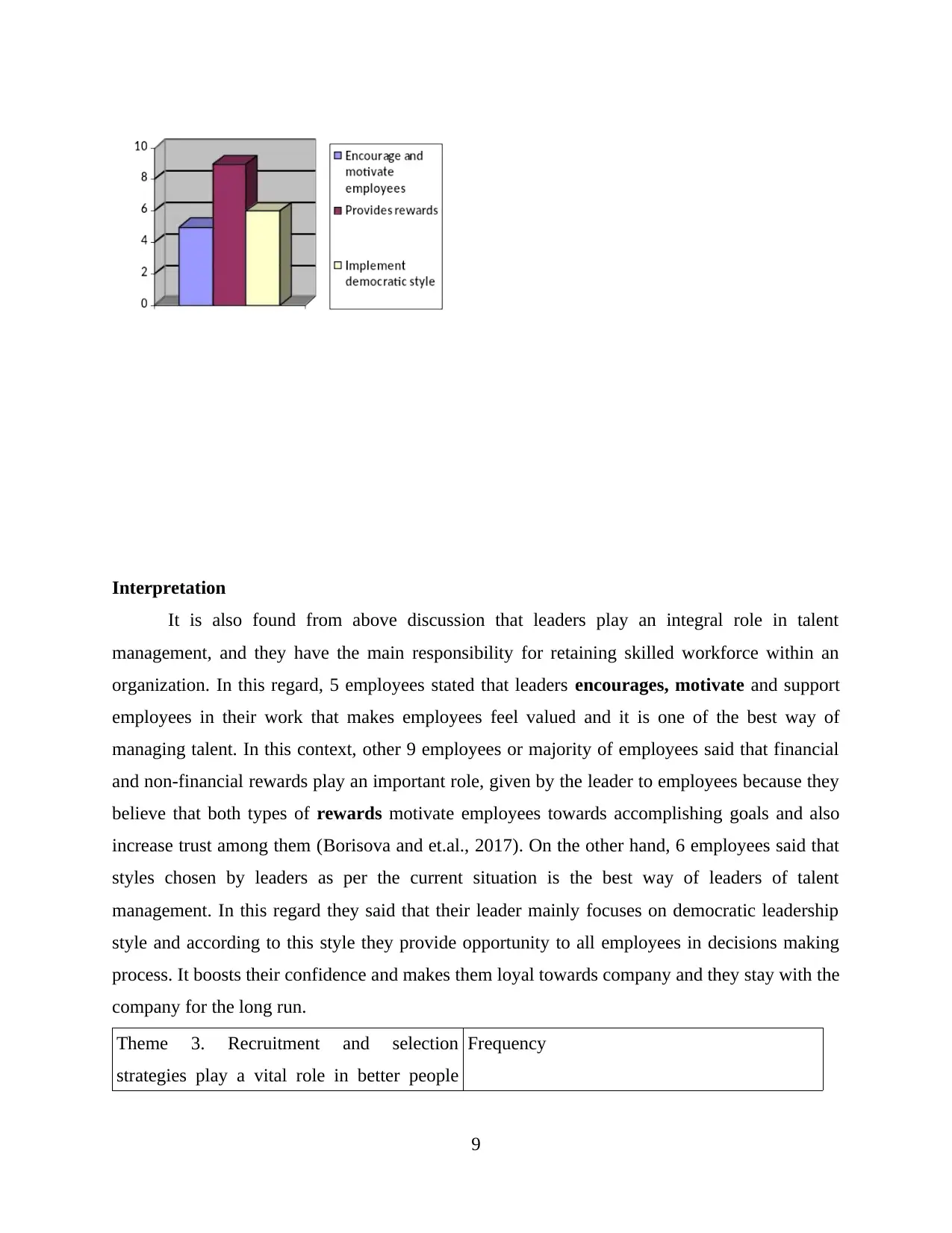
Interpretation
It is also found from above discussion that leaders play an integral role in talent
management, and they have the main responsibility for retaining skilled workforce within an
organization. In this regard, 5 employees stated that leaders encourages, motivate and support
employees in their work that makes employees feel valued and it is one of the best way of
managing talent. In this context, other 9 employees or majority of employees said that financial
and non-financial rewards play an important role, given by the leader to employees because they
believe that both types of rewards motivate employees towards accomplishing goals and also
increase trust among them (Borisova and et.al., 2017). On the other hand, 6 employees said that
styles chosen by leaders as per the current situation is the best way of leaders of talent
management. In this regard they said that their leader mainly focuses on democratic leadership
style and according to this style they provide opportunity to all employees in decisions making
process. It boosts their confidence and makes them loyal towards company and they stay with the
company for the long run.
Theme 3. Recruitment and selection
strategies play a vital role in better people
Frequency
9
It is also found from above discussion that leaders play an integral role in talent
management, and they have the main responsibility for retaining skilled workforce within an
organization. In this regard, 5 employees stated that leaders encourages, motivate and support
employees in their work that makes employees feel valued and it is one of the best way of
managing talent. In this context, other 9 employees or majority of employees said that financial
and non-financial rewards play an important role, given by the leader to employees because they
believe that both types of rewards motivate employees towards accomplishing goals and also
increase trust among them (Borisova and et.al., 2017). On the other hand, 6 employees said that
styles chosen by leaders as per the current situation is the best way of leaders of talent
management. In this regard they said that their leader mainly focuses on democratic leadership
style and according to this style they provide opportunity to all employees in decisions making
process. It boosts their confidence and makes them loyal towards company and they stay with the
company for the long run.
Theme 3. Recruitment and selection
strategies play a vital role in better people
Frequency
9
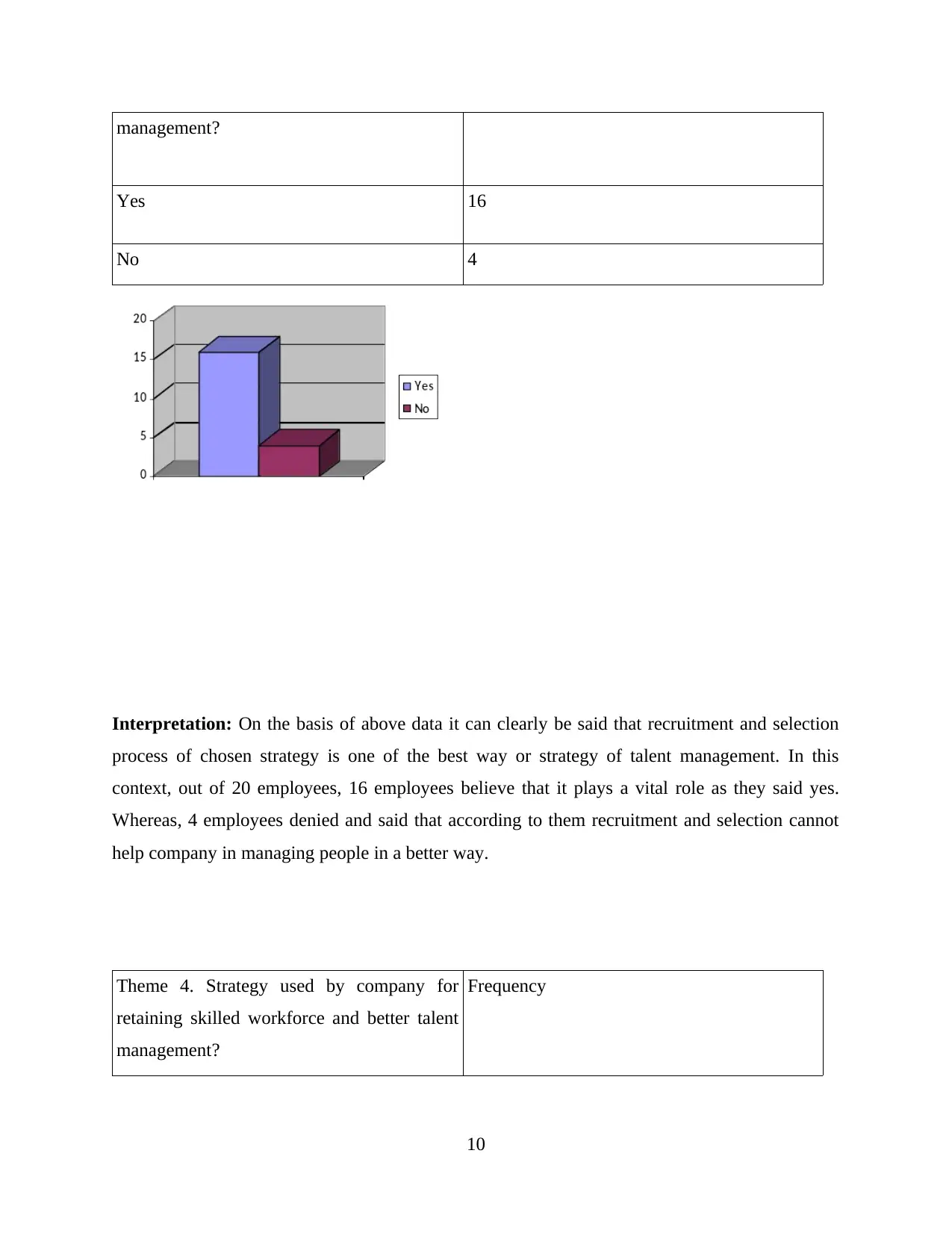
management?
Yes 16
No 4
Interpretation: On the basis of above data it can clearly be said that recruitment and selection
process of chosen strategy is one of the best way or strategy of talent management. In this
context, out of 20 employees, 16 employees believe that it plays a vital role as they said yes.
Whereas, 4 employees denied and said that according to them recruitment and selection cannot
help company in managing people in a better way.
Theme 4. Strategy used by company for
retaining skilled workforce and better talent
management?
Frequency
10
Yes 16
No 4
Interpretation: On the basis of above data it can clearly be said that recruitment and selection
process of chosen strategy is one of the best way or strategy of talent management. In this
context, out of 20 employees, 16 employees believe that it plays a vital role as they said yes.
Whereas, 4 employees denied and said that according to them recruitment and selection cannot
help company in managing people in a better way.
Theme 4. Strategy used by company for
retaining skilled workforce and better talent
management?
Frequency
10
⊘ This is a preview!⊘
Do you want full access?
Subscribe today to unlock all pages.

Trusted by 1+ million students worldwide
1 out of 22
Related Documents
Your All-in-One AI-Powered Toolkit for Academic Success.
+13062052269
info@desklib.com
Available 24*7 on WhatsApp / Email
![[object Object]](/_next/static/media/star-bottom.7253800d.svg)
Unlock your academic potential
Copyright © 2020–2025 A2Z Services. All Rights Reserved. Developed and managed by ZUCOL.





